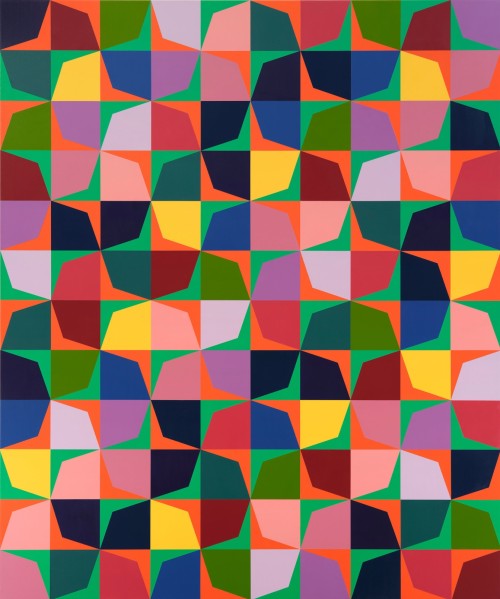
Odili Donald Odita: Degrees of Separation
Degrees of Separation features a group of new paintings in which Odita poses pointed questions about the meaning and perception of darkness in a variety of social and aesthetic contexts. In so doing, he elaborates and expands upon themes that have characterized his work for more than twenty years, exploring ways in which color, line, geometry, implied movement, and patterning inform shared experiences of the world at large. Executed with acrylic paints on either canvas or reconstituted wood panels, the paintings are distinguished by shifting, angular, and ray-like compositions in which apparent symmetries and grid-oriented images of order are offset by the visceral, structuring function of color. Odita is known for his commitment to mixing pigments by hand anew for each painting, so that the same color never appears in his work twice.
Odita brings the fullest possible array of technique, conceptual analysis, and sociopolitical critique to the practice of painting. The results of this radical synthesis are works that engage the eye, body, and mind in equal degree, and that focus attention not only on their own compositional and chromatic qualities, but on elements of identity and cultural production that are consistently excluded from dominant points of view. By forging parallels between visual constructs like perspective or the indeterminacy of color and observations about mechanisms of power and psychological bias, Odita repositions painting as a force that engenders new kinds of seeing, and that enables its viewers and makers to perceive facets of their physical and epistemological environments that might otherwise go unseen.
In a text that accompanies the exhibition, the artist points out the place where the word “dark” has been relegated in the structures of color theory and the language used to describe it:
When we think of ‘shadow colors’ or values that move away from the spectrum of white, it is often said that these colors lack light or diminish in value. On the contrary, darker colors are simply another degree of color and/or value which is distinguishable from all other colors or values on a color/value spectrum.
By bringing this objective lens to the science of color, Odita also begins to unpack the layers of cultural meaning that accrue around it, noticing how the phenomenon of darkness shows up wherever and whenever people associated with dominant institutions attempt to disenfranchise other groups of people and non-majority ideas. There are parallels between such value distinctions, Odita points out, and the distinctions usually assumed to be part and parcel of the experience of color itself.
The works in this exhibition demonstrate, in an invigorating variety of permutations, how darkness is in fact a mode of generative seeing and feeling that includes such states as contemplation, rest, and, perhaps contrary to prevailing expectations, profound luminosity. Odita modulates his responses to this condition by positioning colors so that they echo in social, aesthetic, and optical spheres alike. In Subculture (2023), for example, staggered columns of diamond and zig-zagging forms conceal, build upon, and etch their way into one another; deep blues, blacks, and siennas jostle up against more ethereal blues, greens, and yellows, with the former providing a pervasive intensity that transforms two-dimensional shapes into what seem to be three-dimensional objects. The deeper tones therefore do not so much provide a background as they do create an overall sense of space, containment, movement, and possibility.
By establishing chromatic relationships of this kind, Odita takes apart familiar color-based strategies that animate canonical lineages of Renaissance, Romantic, and cubist painting, reassembling and repurposing them to describe and embody a reality that is much broader than the pictorial one around which those lineages are built. Seen from this point of view, fixed ideas about foreground and background, for instance, are—at least partially—products of entrenched ideas about color that can just as easily be rearranged and reimagined. Such reimagination has been occurring across the globe, of course, for as long as humans have made art, which suggests that, in addition to the arbitrary nature of its dictates, the presiding view is as limited as its prejudices.
The artist’s interest in abstraction is fueled by the utopian impulses with which it has historically been intertwined. But as Odita makes plain in works like Open (2023), the political dimension is one part, however important, of an even broader program to employ abstraction to see beyond and through conceptual limitations that are enforced by political agendas. Almost six feet tall and twelve feet wide, the painting simultaneously establishes and dismantles what appear to be numerous vanishing points. Ideas about perspective, figure, ground, appearance, and disappearance all find articulation through the medium of color. Though the work bristles with visual energy, it seems to suggest that true power lies in the unseen, and that abstraction is uniquely equipped to make contact to what has been closed off, shut down, and excluded from view.
Odili Donald Odita has been the subject of solo exhibitions at institutions including the Virginia Museum of Fine Arts, Richmond, Virginia (2020); Institute of Contemporary Art, Miami (2019); and Nasher Museum of Art at Duke University, Durham, North Carolina (2015). Notable group exhibitions include New Grit: Art & Philly Now, Philadelphia Museum of Art (2021); Generations: A History of Black and Abstract Art, Baltimore Museum of Art (2019); How We See: Materiality of Color, Laumeier Sculpture Park, St. Louis (2019); Front International: Cleveland Triennial for Contemporary Art: An American City, Cleveland (2018); Prospect 4: The Lotus in Spite of the Swamp, New Orleans (2017); Think with the Senses – Feel with the Mind: Art in the Present Tense, 52nd Venice Biennale, Italy (2007). Odita’s work is in the permanent collections of numerous museums, including the Baltimore Museum of Art; Pérez Art Museum, Miami; Philadelphia Museum of Art; San Francisco Museum of Modern Art; and The Studio Museum in Harlem, New York. Odita lives and works in Philadelphia.